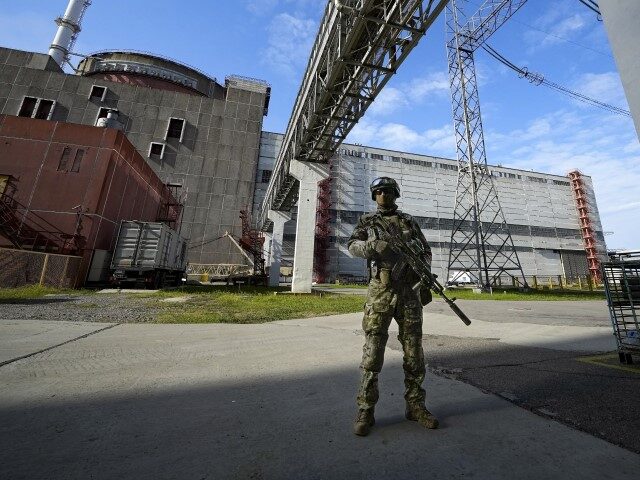The U.N.’s International Atomic Energy Agency (IAEA) announced on Thursday that its Director-General Rafael Grossi will visit the Russian region of Kursk next week to examine its nuclear power plant, which officials worry invading Ukrainian troops may damage.
Ukraine, over two years into fighting a full-scale Russian invasion, launched a counter-invasion into Russia on August 6, seizing significant territory in the Kursk border region and rapidly threatening to expand into neighboring Belgorod and Bryansk, but since halting mostly in Kursk. Ukrainian officials initially omitted public discussion on the operation, but ultimately described it as necessary to create a “buffer zone” that blocks Russia from deploying troops into war-torn, occupied eastern Ukraine.
Concerns about a nuclear accident at the Kursk Power Plant add to years of alarm surrounding the Russian presence at a similar facility in Zaporizhzhia, a Ukrainian territory that Russian strongman Vladimir Putin “annexed” in September 2022. Both Russia and Ukraine have for years accused each other of plotting to weaponize the Zaporizhzhia Nuclear Power Plant by bombing it, effectively turning it into a “dirty” weapon.
The site of the worst nuclear disaster in history, the Chernobyl Nuclear Power Plant, also attracted alarm in the early days of the full-scale Russian invasion, as soldiers occupied it, but Ukraine ultimately regained control of the Chernobyl exclusion zone and it has since become less of a concern than the more functional sites in Zaporizhzhia and Kursk.
A senior Russian diplomat confirmed on Thursday that Grossi would soon visit Kursk, and specifically set foot in the Kursk nuclear power plant. The IAEA similarly told reporters that the visit would occur “next week,” without elaborating.
The United Nations agency immediately began warning Russia and Ukraine to avoid damaging the nuclear plant after initial reports revealed in early August that Ukraine had crossed the border into Kursk. Grossi himself reportedly warned, according to the Ukrainian state outlet Ukrinform, that the Kursk plant was especially vulnerable because “the obsolete Soviet reactors have no special protective dome above them, which leaves the reactor core rather exposed.”
“Given that the Ukrainian troops are advancing in the area, coming close to the NPP, within the artillery range, this poses a major concern for agency [sic], Grossi said,” according to Ukrinform.
The Soviet Union began building the Kursk Nuclear Power Plant in 1971 and it went online in 1976, a decade before the Chernobyl disaster. According to the Russian government, the plant currently boasts four nuclear reactors and was in the process of being upgraded with new reactors when Ukraine invaded.
The Russian Foreign Ministry suggested on August 17 that Ukrainian officials had already begun planning to attack the plant.
“We call on the international organizations – in particular, the United Nations and the IAEA – to immediately state their condemnation of the provocative actions begin [sic] prepared by the Kiev regime,” spokeswoman Maria Zakharova said at the time, “and to prevent a violation of nuclear and physical security of the Kursk NPP, which may result in a large-scale man-made disaster in Europe.”
That same day, the IAEA issued a statement expressing concern about the possibility of a nuclear disaster in the Ukrainian war theater, but not in Kursk – in Zaporzhzhia, one of the four regions Putin “annexed” in 2022.
“Yet again we see an escalation of the nuclear safety and security dangers facing the Zaporizhzhya Nuclear Power Plant,” Grossi said in a statement on August 17. “I remain extremely concerned and reiterate my call for maximum restraint from all sides and for strict observance of the five concrete principles established for the protection of the plant.”
“Nuclear power plants are designed to be resilient against technical or human failures and external events including extreme ones, but they are not built to withstand a direct military attack,” Grossi continued, “and neither are they supposed to, just as with any other energy facility in the world.”
“This latest attack highlights the vulnerability of such facilities in conflict zones and the need to continue monitoring the fragile situation,” he concluded.
The statement was prompted by a drone strike near the plant, which the Russians blamed on Ukraine.
“As reported earlier, Russia is massively spinning a false accusation against Ukraine, claiming the country is allegedly plotting a ‘dirty bomb’ attack on the ZNPP [Zaporizhzhia nuclear plant],” Ukrinform countered.
The Ukrainian invasion of Kursk was tremendously successful in its first days, according to both Russian and Ukrainian sources. The governor of Kursk, Alexei Smirnov, told Putin last week that he planned to evacuate 180,000 people from affected areas and had already displaced 121,000.
“Currently, the enemy controls 28 communities. They have penetrated 12 kilometres deep into the territory of the Kursk Region, with a 40-kilometre-wide frontline,” he said on August 12.
Since then, however, reports indicate that the Russians have regrouped and prevented the Ukrainians from taking more land, stopping attacks on neighboring Bryansk and Belgorod. The Ukrainians, meanwhile, are reportedly struggling with training new recruits.
“Some people don’t want to shoot,” a battalion commander told the Associated Press in an article published on Thursday. “They see the enemy in the firing position in trenches but don’t open fire. … That is why our men are dying.”

COMMENTS
Please let us know if you're having issues with commenting.